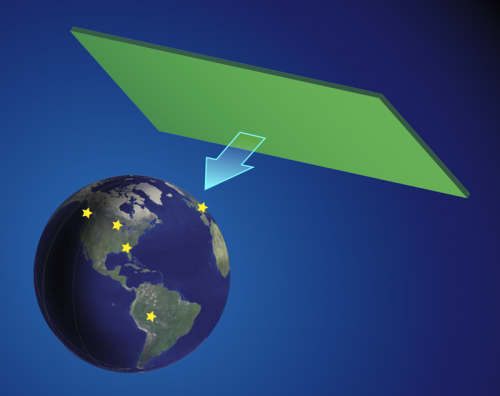January 21, 2013 report
Physicists looking to test theory of 'cosmic domain walls'

(Phys.org)—An international team of physics researchers is looking to add credence to a theory that might help explain the nature of dark matter and dark energy – using magnetometers placed strategically around the globe. As they describe in their paper published in Physical Review Letters, the aim is to measure the energy in the walls of theoretic domains that control both dark matter and dark energy.
For several years, physicists have searched in vain for an explanation of dark matter – the invisible "stuff" that makes up what is believed to be approximately 86 percent of all matter, and dark energy – the mysterious force believed to be responsible for the accelerating expansion of the universe. Because thus far no evidence has been found to support any theory that explains either, new theories continue to develop. One is the theory of cosmic domain walls. It's based on the idea that shortly after the Big Band, the universe had random energy fields, but as things cooled, different energy regions began to form dominated by an energy factor, with walls between the different regions – and that's how things stand today. A model might look like a bunch of soap bubbles that have been pushed together. The flat walls that exist at the juncture points would represent the cosmic domain walls.
In this new research effort, the aim is to measure the energy in these walls, to hopefully learn more about them and by extension, more about the nature of dark matter and dark energy. The team members believe that it should be possible to test for the energy they are looking for using simple magnetometers. But it would have to be more than one of course, because there are so many things that can be recorded by such devices – it would be difficult to attribute any readings found from just one or even two, to cosmic domain walls. To get around that problem, they propose setting up five of the devices at various locations around the globe, and then correlating them together to rule out interference and other noise.
The team isn't suggesting that if they find what they believe to be the existence of cosmic domain walls, that answers regarding dark matter and dark energy will follow soon thereafter – instead, they are simply hoping to add credence to a theory that many currently consider far outside of the domain of mainstream science.
More information: Detecting Domain Walls of Axionlike Models Using Terrestrial Experiments, Phys. Rev. Lett. 110, 021803 (2013) prl.aps.org/abstract/PRL/v110/i2/e021803
Abstract
Stable topological defects of light (pseudo)scalar fields can contribute to the Universe's dark energy and dark matter. Currently, the combination of gravitational and cosmological constraints provides the best limits on such a possibility. We take an example of domain walls generated by an axionlike field with a coupling to the spins of standard-model particles and show that, if the galactic environment contains a network of such walls, terrestrial experiments aimed at the detection of wall-crossing events are realistic. In particular, a geographically separated but time-synchronized network of sensitive atomic magnetometers can detect a wall crossing and probe a range of model parameters currently unconstrained by astrophysical observations and gravitational experiments.
Journal information: Physical Review Letters
© 2013 Phys.org



















